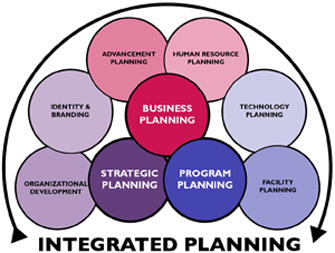Integrated Planning
The point of planning is to look at where you are, determine where you want to go, and figure out what it will take to get there. After gathering and analyzing data of various sorts, and involving people with a range of wisdom and perspectives, you can chart a course toward achieving your mission. Strategic planning is a necessary, but often not a sufficient, component of a nonprofit planning process.
We use the term integrated planning to describe a composite of planning activities that together provide the structure, direction and guidance needed by an organization. While the composite will vary in different situations, an understanding of the principles and framework for integrated planning will help to make each of the components easier to value, pursue and implement effectively.

At the core of integrated planning are strategic, program, and business planning, the why?, what? and how? of the organization.
Strategic Planning
The term “strategic planning” gets thrown around very loosely in the nonprofit world, to cover a wide variety of intentions and activities. The intentions are often poorly defined and/or ill-suited to the activities. The resulting lack of focus and eventual failure of the process leave participants with a negative impression of planning.
For many stakeholders, especially trustees who come from the world of business, strategic planning retains the rigid, top-down, market-driven, bottom-line-focused associations of its corporate roots. In the nonprofit sector, strategic planning requires a very different profile.
Here, it is fundamentally broad-based consensus-building around mission and goals. While strategic planning is one of the primary fiduciary responsibilities of the board, at its best it draws all stakeholders into a discussion that reinvigorates a sense of communal purpose, and develops strategic thinking, focus, and leadership at all levels, as well as defining goals and actions (see Critical Issues #1: Why Plan?).
Program and Business Planning
Despite differences of strategy, a nonprofit does have the same underlying existential needs as a for-profit enterprise. Services and programs (products) must be developed with professional expertise. Revenues from one source or another must exceed expenses if the organization is to survive. Since the inclusive, consensus-driven process of nonprofit strategic planning is not well suited to the expertise-driven nature of business and program planning, they need to be separate undertakings.
Program planning develops services, programs and delivery mechanisms, and identifies the resources needed to implement them. While these concerns intersect with strategy and business issues, they are at their core the responsibility of the CEO / executive director and the professional staff. A program plan may well be reviewed at the policy level by the board, but it should be developed by the professionals who report to the CEO (faculty, program directors, department heads, etc.).
A business plan details the means by which the organization is to be supported and sustained, determines operational feasibility, and provides the staffing, financial, market, and operational details required. Business planning typically is the responsibility of the Executive Director and CFO, and sometimes the board.
The Planning Cycle
The three core areas of planning approach the same essentials from different angles: strategic planning addresses the questions of why? , program planning addresses what? , and business planning addresses how?
Since there is clearly overlap among them, you can start with one, and strengthen it further when you develop the others.
For an organization with no experience in planning, a very quick strategic plan may be able to provide the context for more detailed program and business planning. After these are in place, the organization can cycle back to a more extensive strategic planning process, perhaps a year or two later.
Ideally you need all three, but trying to develop them in one undifferentiated process by a single group of people will generally be unwieldy and frustrating and will leave some or all of the planning compromised.
A regular, integrated cycle of strategic, program and business planning reinforced with the peripheral supporting areas shown in the diagram and described in the sidebar can foster a culture of planning, in which the efforts of the entire organization converge through strategic thinking on critical issues. While there are other areas of planning that could be factored into an integrated planning composite, the core and peripheral areas included here cover most of the usual ground.
Fitting the Pieces Together
Often strategic planning is used as the umbrella activity. This can be done in any number of ways. Goals, objectives and measurable actions from the program and business plans can be added as separate sections toward the end of the strategic planning process. Or there may be shared objectives that can be merged into a single document. Different functional areas (advancement, human resources, technology, specific programs and services) may develop annual plans that support and annually refresh a multi-year strategic plan. Each of these approaches to integration makes the strategic plan the shared connector between mission and metrics.
The idea of an integrated plan is primarily a recognition of connectedness. It is not enough to be excellent at planning and implementing operations within an individual function. An all-too-common weakness in a nonprofit is the lack of coordination among finance and fundraising, membership and communications, issues and infrastructure.
Working together is not easy. But it is likely to be much more effective. An integrated planning process can lead the way to other synergies.